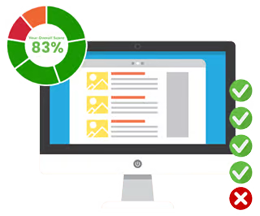What Are Listicles and When Should They Be Used?

The internet is saturated with content, and readers often skim rather than dive into lengthy articles. This is where listicles come in. A blend of “list” and “article,” listicles are a popular format in digital content that delivers information in an organised, easy-to-read list. In this post, we’ll explore what makes listicles effective, when to use them, and tips for creating listicles that engage and inform.
What Is a Listicle?
A listicle is a type of article structured as a list, often with brief descriptions or explanations for each item. Listicles are typically identified by numbers in the title, like "10 Tips for Healthy Eating" or "7 Ways to Boost Your Productivity." This format is visually appealing and easy to digest, making it popular for both creators and readers.
Why Listicles Work:
- Easy to Skim: Listicles allow readers to jump to specific points of interest quickly.
- Visually Engaging: Breaking information into bite-sized chunks reduces cognitive load.
- Encourages Engagement: Listicles often prompt readers to keep reading to see the full list.
- Mobile-Friendly: The format translates well to mobile devices, catering to today’s mobile-first audience.
6 Types of Listicles and When to Use Them
Listicles can vary widely in tone, depth, and purpose. Here are 6 common types and the best times to use each:
1. How-To Listicles
- What It Is: These listicles guide readers through steps or tips to accomplish a specific task. Example: "10 Steps to Organise Your Workspace."
- When to Use It: Ideal for audiences seeking actionable advice, from DIY projects to skill-building and personal development.
2. Tips and Tricks Listicles
- What It Is: Listicles with helpful hints and strategies on a specific topic. Example: "8 Tricks to Save Money While Traveling."
- When to Use It: Great for engaging readers who are looking for quick, expert advice on a subject they care about.
3. Best of/Recommendations Listicles
- What It Is: These feature top picks or favourites in a particular category. Example: "15 Best Productivity Apps for Entrepreneurs."
- When to Use It: Perfect for consumers seeking recommendations. This type of listicle works well in affiliate marketing or when promoting products and services.
4. Educational or Informative Listicles
- What It Is: These listicles aim to educate the reader on a topic. Example: "10 Facts About Climate Change Everyone Should Know."
- When to Use It: Use this format when trying to inform or spread awareness, especially for complex subjects that benefit from clear, structured information.
5. Mistakes to Avoid Listicles
- What It Is: Focused on highlighting common errors within a particular topic. Example: "5 Common Mistakes New Investors Make."
- When to Use It: Effective for audiences learning something new or seeking to improve. This format provides a fresh perspective and is popular in self-help and industry-specific content.
6. Checklist Listicles
- What It Is: These provide a list of things readers should have, do, or check. Example: "12 Things to Pack for a Weekend Getaway."
- When to Use It: Perfect for readers looking for practical guidance. This format helps organize actions or items, making it ideal for travel, event planning, or preparing for significant tasks.
When to Use Listicles in Your Content Strategy
Listicles are effective in many scenarios, but they work best when aligned with your audience’s needs and preferences. Here are some situations where listicles shine:
1. When Your Audience Prefers Quick, Actionable Content
Listicles are perfect for readers who need information quickly, without lengthy explanations. Whether it’s a busy professional or a casual reader, listicles cater to short attention spans.
2. When Covering Broad Topics
For complex or broad subjects, listicles help break down information into manageable pieces. If your topic has multiple dimensions, presenting it as a list keeps it structured and engaging.
3. When Looking to Boost Engagement
Listicles are inherently engaging because readers are inclined to see the list through to the end. Use listicles when you want to increase time-on-page or get readers to explore related content.
4. When Targeting SEO with Specific Keywords
Listicles are often SEO-friendly because they naturally fit into high-ranking search formats (e.g., "Top 10" or "Best Of" articles). Search engines favour well-organised content that provides a clear answer, which listicles deliver.
5. When Promoting Products or Services
Listicles are excellent for showcasing multiple products, services, or tools, making them popular in affiliate marketing. By organising offerings in a list, you can highlight various options and link to each product, maximising click-through potential.
Tips for Writing Effective Listicles
Creating listicles that engage and inform requires more than just throwing items together. Here are some best practices:
1. Choose a Relevant and Attention-Grabbing Title
The title is crucial for drawing readers in. Use numbers to attract attention and consider power words to make the title pop. For example, “10 Essential Tools for Digital Marketing” is more enticing than “Some Digital Marketing Tools.”
2. Organise and Number Your Points Clearly
Clear structure is key to a good listicle. Use subheadings, keep each point focused on a single idea, and number each item. This makes it easier for readers to skim or find specific points of interest.
3. Add Visuals to Break Up Text
Visual elements, such as images, icons, or infographics, enhance engagement. They also help readers process information and retain it more effectively.
4. Keep Points Concise and Informative
Each item on the list should add value and stick to the main point. Avoid adding unnecessary details that might overwhelm the reader.
5. Deliver Value and Actionable Insights
Aim to provide practical information the reader can use. Offering real examples, actionable tips, or expert insights will make your listicle memorable and useful.
6. End with a Strong Conclusion or Call-to-Action
Wrap up with a summary or encourage readers to take the next step, whether it’s exploring more on your site, subscribing to your newsletter, or trying out a product.
*****
Listicles are a versatile and engaging format that can be used for various types of content. Whether you’re educating, recommending, or helping readers avoid common mistakes, listicles provide an easy-to-read, structured approach that resonates with audiences. By understanding when and how to use listicles, you can enhance your content strategy, meet reader expectations, and create memorable content that keeps them coming back for more.
Experiment with different types of listicles, and don’t be afraid to get creative with your lists. Happy writing!





